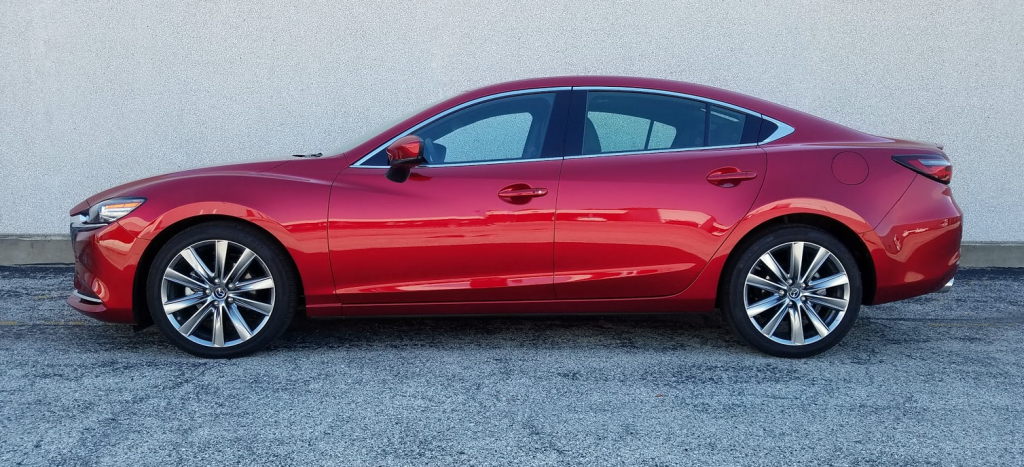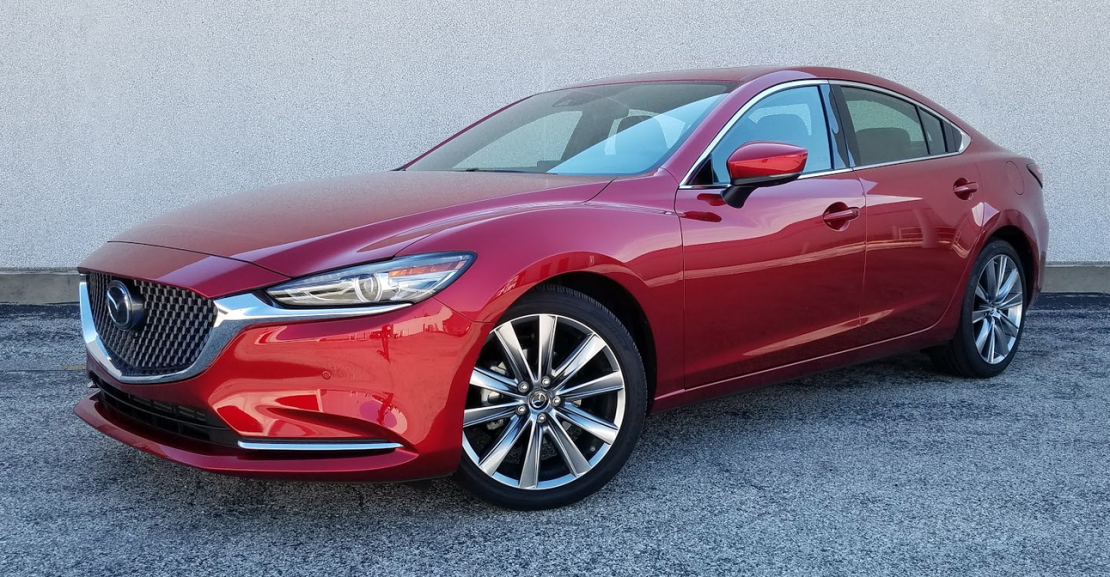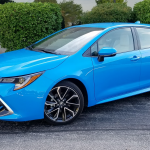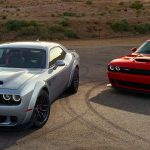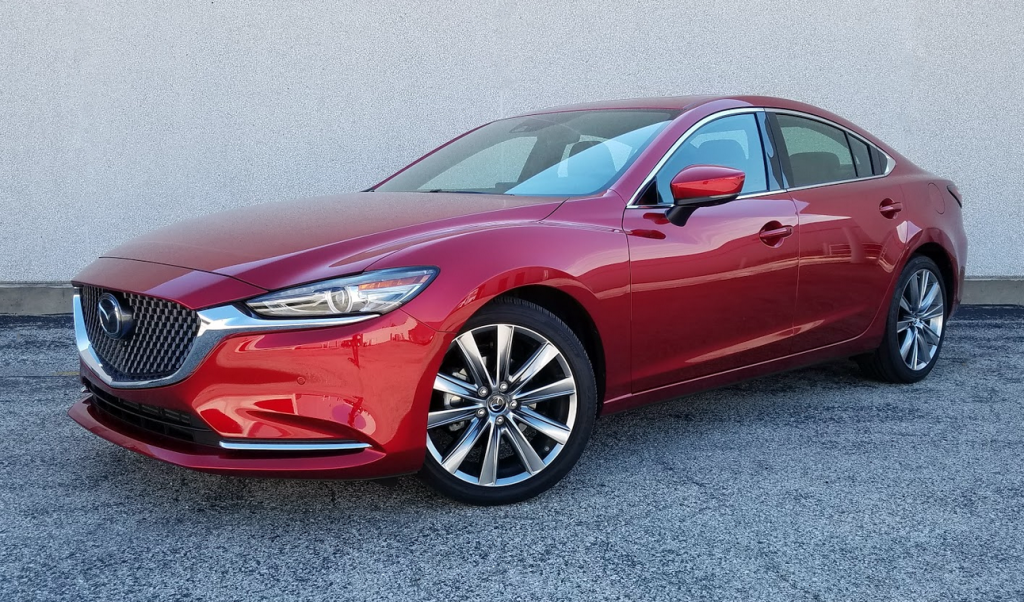
 2018 Mazda 6 Signature
2018 Mazda 6 Signature
Class: Midsize Car
Miles driven: 454
Fuel used: 19.4 gallons
Real-world fuel economy: 23.4 mpg
Driving mix: 75% city, 25% highway
| CG Report Card | |
|---|---|
| Room and Comfort | B+ |
| Power and Performance | B+ |
| Fit and Finish | A |
| Fuel Economy | B- |
| Value | B+ |
| Report-card grades are derived from a consensus of test-driver evaluations. All grades are versus other vehicles in the same class. Value grade is for specific trim level evaluated, and may not reflect Consumer Guide's impressions of the entire model lineup. | |
| Big & Tall Comfort | |
| Big Guy | A- |
| Tall Guy | B+ |
| Big & Tall comfort ratings are for front seats only. "Big" rating based on male tester weighing approximately 350 pounds, "Tall" rating based on 6'6"-tall male tester. | |
EPA-estimated fuel economy: 23/31/26 (city, highway, combined)
Base price: $34,750 (not including $890 destination charge)
Options on test vehicle: Cargo mat ($75), Soul Red Crystal paint ($595), door-sill scuff plates ($125)
Price as tested: $36,435
Quick Hits
The great: Refined and upscale cabin, satisfying power
The good: Plenty of passenger space
The not so good: Disappointing fuel economy for a Mazda
More Mazda price and availability information
John Biel
A lot of automakers like to talk about continuous improvement of their products. For 2018, Mazda shows them how it’s done with the midsize 6 sedan.
While not enough of a revamp to consider it a whole new generation, what’s been done to the 6 is substantial. It addresses a few perceived shortcomings, even as it positions the car in some different territory. There’s a new engine choice, a redesigned interior, modified exterior styling, some new features, structural improvements, and reworked suspension geometry.
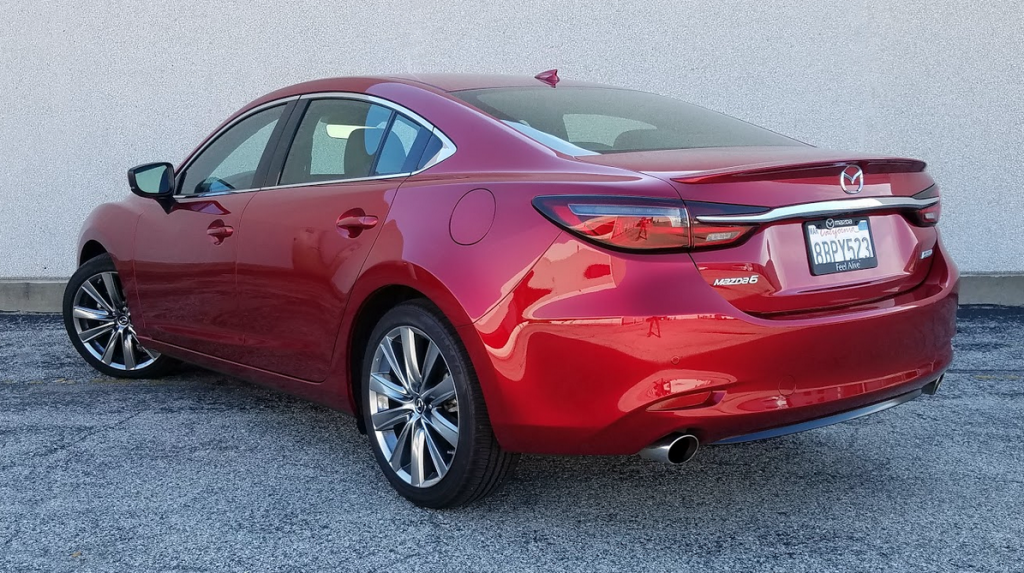
Mazda adds a pair of trim levels at the top end, the Grand Touring Reserve and the Signature. Consumer Guide® tested the latter, which sits at the pinnacle of pricing: $35,640 with delivery. A trio of individual options nudged the test car’s final price to $36,435.
Test Drive: 2018 Honda Accord Touring 1.5T
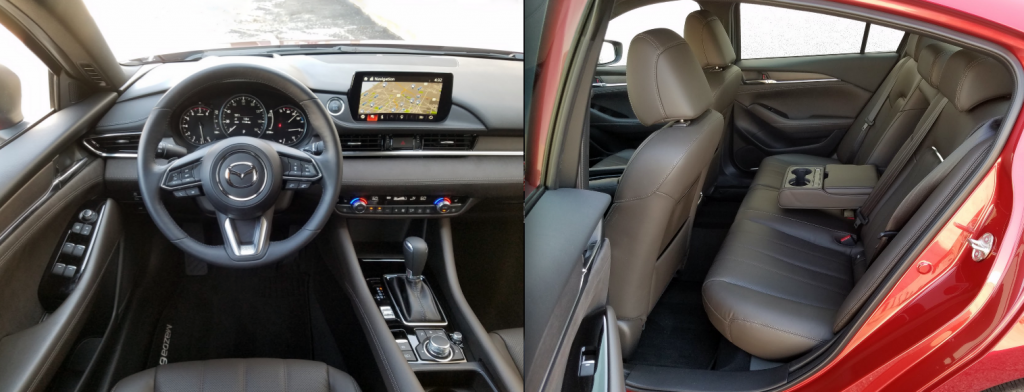
The 2.5-liter naturally aspirated 4-cylinder engine that had been the Mazda 6’s sole motivator is back (at 187 horsepower, a gain of three), but it is newly joined by a turbocharged variant that makes 250 horsepower on premium gasoline or 227 ponies on regular. The turbo mill is standard in Grand Touring, Grand Touring Reserve, and Signature models. The extra horsepower and 310 lb-ft of torque that peaks at 2000 rpm make the 6 feel pretty eager for what’s essentially a family sedan, and that’s true in most driving situations.
Steve and Johnnie Road Test: 2017.5 Mazda 6 i Grand Touring
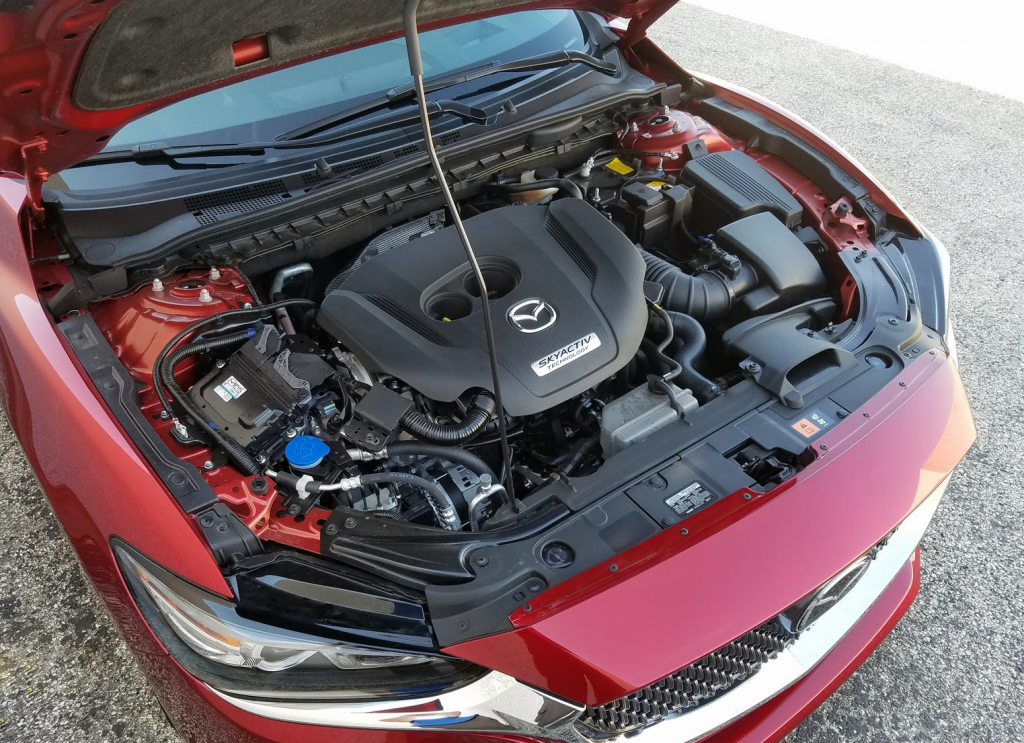
The smoothly effective 6-speed automatic transmission standard on all models save the entry-level Sport (for which a 6-speed manual remains available) includes a “Sport” mode, activated by a switch on the console. It delays upshifts for a little better acceleration when necessary, though at the risk of some fuel economy. Drive-gear and final-drive ratios differ according to which engine is used. The EPA rates the turbo engine/automatic pairing at 23 mpg in city driving, 31 mpg on the highway, and 26 in combined use. In this driver’s 181-mile test composed of 75 percent city-type operation, the car averaged 23.5 mpg.
Ride and handling are continued bright spots as well. “G-Vectoring Control” that adjusts engine torque in response to steering inputs to improve handling and ride quality is standard in all models. CG has made note of the firmly tuned ride from the Mazda 6’s fully independent suspension in recent years, but the ’18 seems a bit more compliant.
The added models serve Mazda’s aim of positioning itself as a slightly upscale automaker with “class-above” refinements relative to other mainstream brands. The Signature displays a fairly sumptuous cabin—Audi-lite in this tester’s estimation. Nappa leather covers the comfortable seats, which are heated and ventilated in front, and heated in the rear. Padded surfaces abound on the redesigned instrument panel, all four doors, and the sides of the center console. Ultrasuede inserts dress up the dash and the door centers, and sections of sen wood heighten the premium look.
Test Drive: 2018 Toyota Camry XSE V6
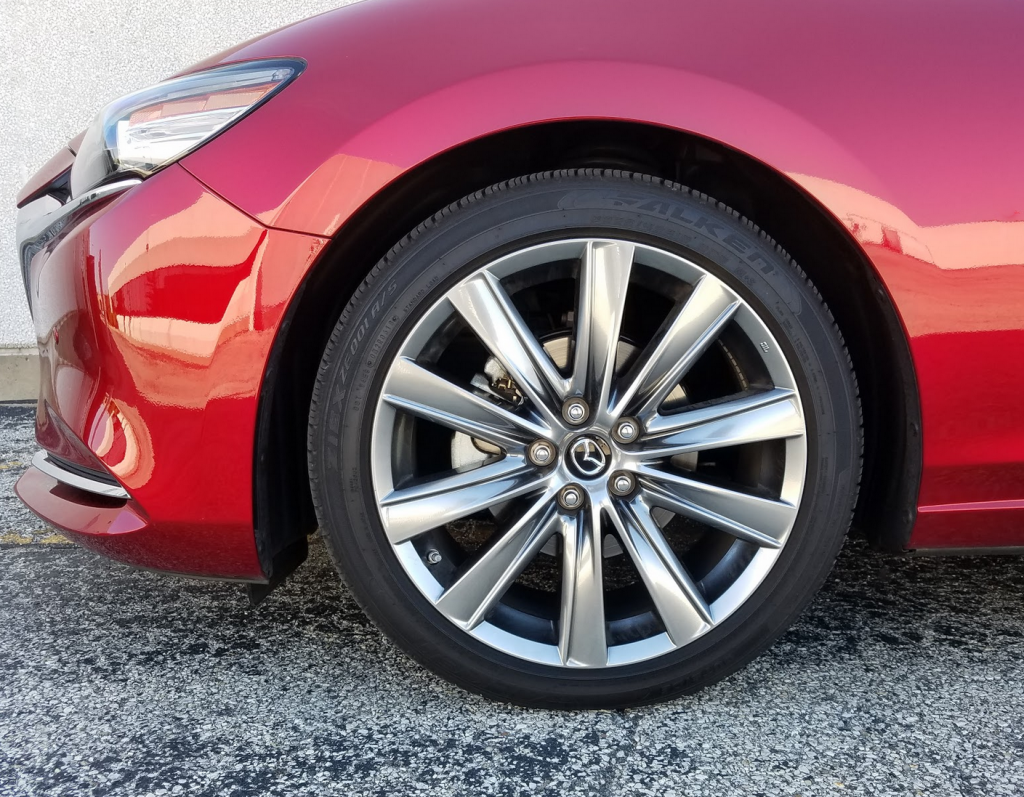
Essentially a fully loaded 6, the Signature comes with Mazda’s Smart City Brake Support system (it automatically applies the brakes to avoid collisions at speeds of less than 20 mph) and two new features, adaptive cruise control with stop-and-go functionality and a 360-degree surround-view monitor. The head-up instrument display is now projected on the windshield instead of the former little tinted window that rose from the instrument panel. Other standards are 19-inch alloy wheels, heated side mirrors, dual bright exhaust outlets, decklid spoiler, Bluetooth connectivity, rearview camera, self-dimming automatic LED headlights, power moonroof, leather-wrapped tilt and telescoping steering wheel, and dual-zone automatic climate control. Infotainment comes from a navigation system and 11-speaker Bose audio (with HD and satellite radio, but no longer with a CD player), displayed on an 8-inch color touchscreen. Electronic driving aids include blind-spot monitoring, rear cross-traffic alert, traffic-sign recognition, lane-departure warning, and lane-keep assist.
Climate controls use a pair of rotating dials to quickly and easily select temperatures, confining the need for less-convenient repetitive-push buttons to fan speed and mode. Unfortunately from our perspective, audio, navigation, communication, and other functions are managed through a console controller that requires some of the driver’s attention to operate, and sometimes complicates processes like audio selection that should be much easier.
With no fundamental changes to the 6’s shape or interior dimensions, it continues to provide good legroom in front and decent space in back. Headroom is in shorter supply in back than it is in front, and a sloping roofline that helps give the car its sharp looks requires rear occupants to do a little bobbing and weaving when entering or exiting. The rear seat effectively holds two adults. For personal-item storage there is a glove box, a modest cubby (with media-device inputs) under the center armrest, and an open bin ahead of the shifter. Front doors have pockets. Rear-seat storage comes down to a bottle holder in each door, pouches on the backs of the front seats, and a shallow covered space and USB port in the pull-down center armrest. The console has two cup holders that can be hidden under a retractable cover; two more drink receptacles are in the rear armrest.
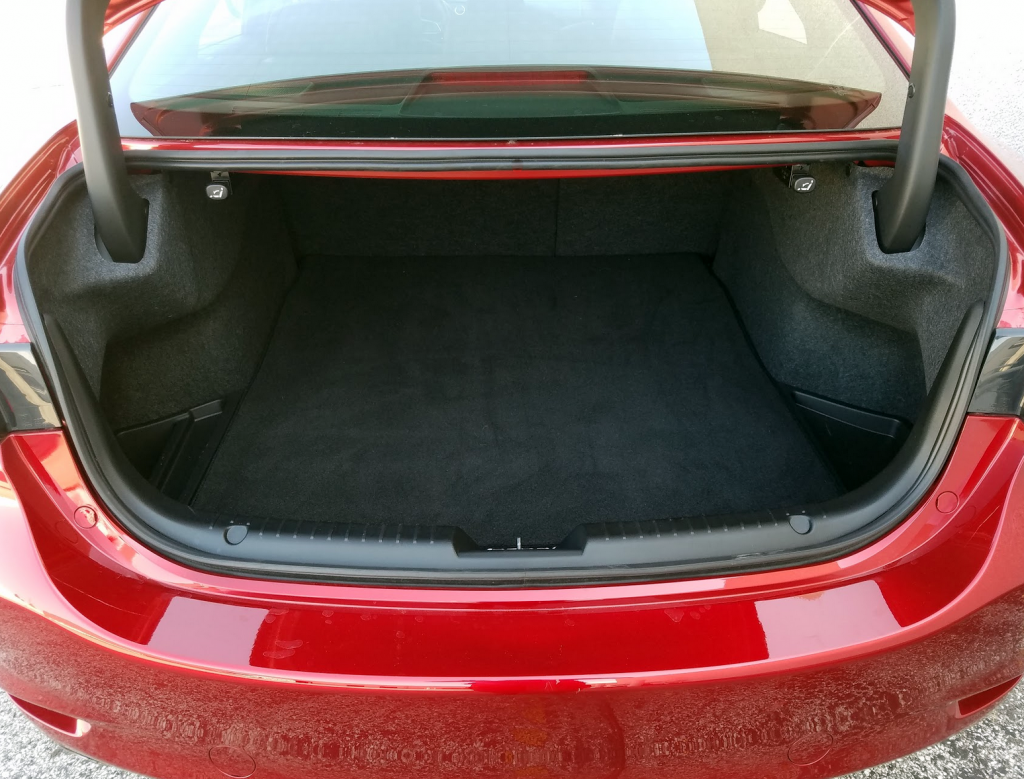
The car’s good trunk space is configured well. While there’s a substantial lip at bumper height, the load floor is long and flat, with bins to hold small items at the rear corners. The rear seats split in a 60/40 break, and fold nearly flat and flush with the trunk floor to deliver extra cargo capacity. The bulkhead behind the rear seat poses almost no impediment to loading long cargo, but when the seats are lowered, the large top latches that hold them in place when up are an exposed obstacle.
With increases in power and luxury for the 6, Mazda is clearly not content to leave well enough alone where its midsize sedan is concerned. Buyers in search of a car that’s useful while still being fun to drive ought to pay attention to it, too.
Test Drive: 2018 Buick Regal TourX
